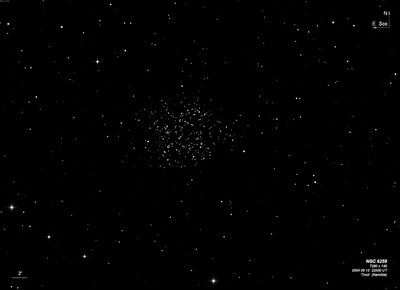
James Dunlop discovered NGC 6259 = D 456 = h3660 on 13 May 1826 and described "a very large patch of strong nebula, about 20' long, and 16' broad, rich in small and extremely minute stars." His position (only to the nearest minute of time in RA) was 11' too far southeast. On 1 Jun 1834, JH called it "a superb, vL, v rich cluster, which fills field; R, vglbM, stars 11..12th mag, thickly sown at intervals from each other from 10" to 20"." On a second sweep he described it as "vL, v rich, fills more than a field, has one or two straggling appendages p and s; stars 11 and 12th mag, nearly equal." JH also found the cluster on 3 Jun 1834 but made a 10 minute transcription error in RA. As a result, h3650 = NGC 6222 is a duplicate observation.
200/250mm - 8" (7/16/82): 12 faint stars mag 11-12.5, over unresolved haze, elongated N-S. Appears to be rich but observed at a very low altitude which diminished the view.
400/500mm - 18" (7/9/02 - Magellan Observatory, Australia): at 128x this cluster appears as a beautifully rich cloud of stars. A couple of hundred stars are resolved in an 8' diameter. Fairly uniform in density and magnitude and roughly circular (similar to NGC 7789). This very rich cluster would be a showpiece for U.S. observers if further north! NGC 6249 lies 33' SW.
Notes by Steve Gottlieb